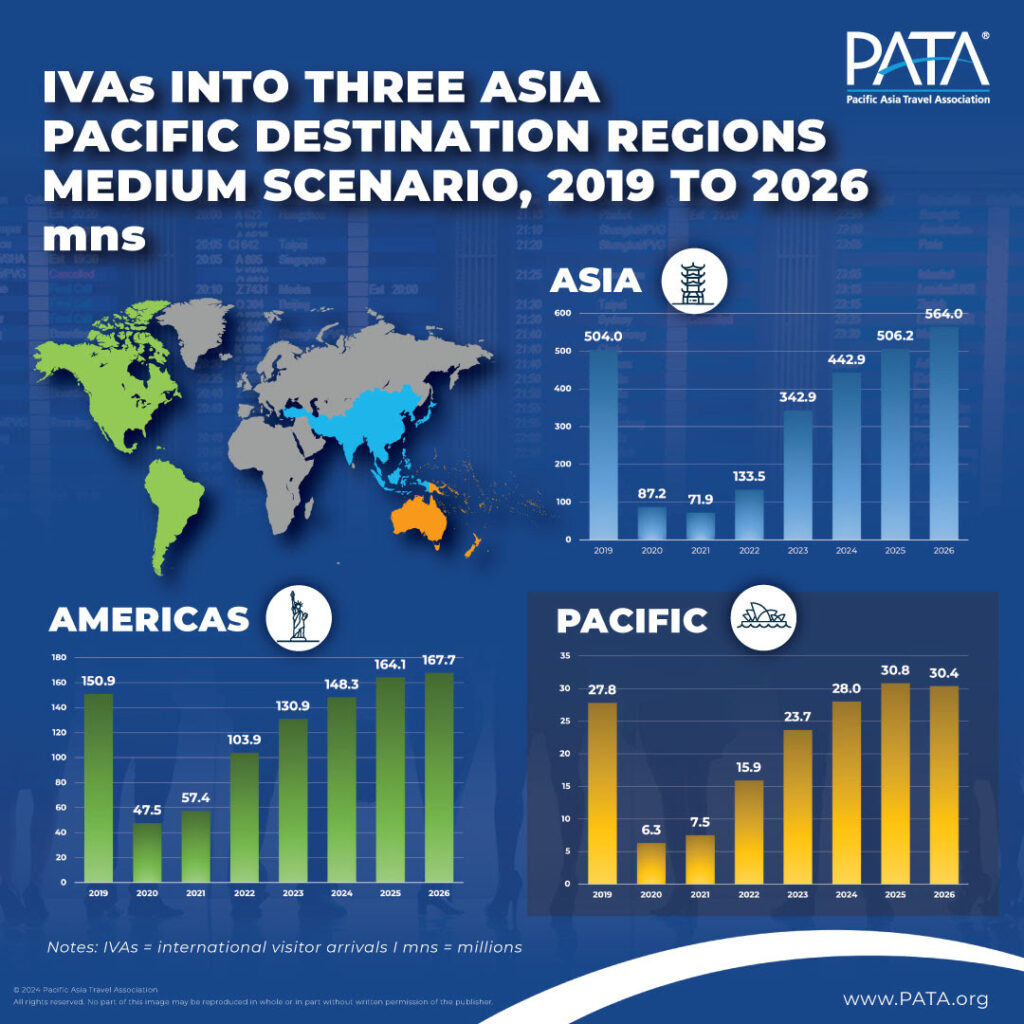PATA’s comprehensive report provides detailed tourism growth forecasts for the Asia-Pacific region and highlights the recovery of various tourism destinations.
Bangkok, Thailand – Following the release of its PATA Executive Summary Forecast Report for 2024 to 2026 early last month, Pacific Asia Travel Association (PATA) has released a more comprehensive Asia Pacific Visitor Forecast 2024-2026 report, digging deeper into growth projections and focusing on the source market and destination mix from 2024 to 2026 for each of Asia Pacific’s three destination sub-regions. The report forecasts 39 destinations within Asia Pacific from 2024 to 2026 across three scenarios.
PATA CEO Noor Ahmad Hamid said: “While most destinations in Asia Pacific have recovered strongly and are approaching pre-pandemic levels, this forecast report highlights the significant changes experienced by individual destinations. It is therefore important to understand these trends which will impact the future growth of each destination compared to the region as a whole.”
In the medium-term scenario, international visitor arrivals (IVA) to Asia Pacific are expected to increase from 619 million in 2024 to 762 million in 2026, representing a recovery of 111.6% compared to 2019 levels. Asia will lead the recovery, reaching 564 million visitors by 2026, followed by the Americas with 167.7 million and the Pacific with 30.4 million, highlighting the region’s resilience and growing destination potential.

When interpreting the Asia Pacific Visitor Forecast 2024-2026 report, it is important to keep in mind that different destinations will recover at different paces, so the data should not be viewed in its entirety. Each destination has its own dynamics, contributing to different percentage changes in international visitor numbers. For example, many destinations in the Pacific region have experienced a strong recovery, but their numbers are understandably on a different scale when compared to larger destinations around the world. Analyzing the projected growth reveals that understanding the nuanced recovery patterns of individual destinations is essential to getting a comprehensive picture of the evolving landscape of tourism in Asia Pacific. PATA emphasizes the importance of observing each destination’s specific recovery rates and trends, as they will shape the overall story of tourism recovery in the region.
Of the 39 destinations featured in the report, 34 are predicted to recover to pre-pandemic levels, with Japan and Maldives topping the list of destinations that will recover the fastest. Japan is expected to welcome 49.3 million tourists by 2026, 155% higher than its 2019 figure. Maldives is expected to welcome 2.5 million tourists, a 148% recovery to pre-pandemic levels. With this in mind, tourism recovery in the region requires proper destination management strategies.
China, the US, the UK and Australia are expected to maintain their leading positions as the major supply markets for IVA to the Asia-Pacific region, with all countries forecast to recover to pre-pandemic levels by 2024, driven by their economic growth potential.
Noor further added, “For destination marketing organisations (DMOs) to be more agile, flexible and robust to rapid changes in the market, especially the output from source markets, will play a key role in which destinations will perform better than others in the coming years. Destination marketers and policy makers need to understand that what they do in 2023 may not work this year onwards as the travel market is changing rapidly and consumer purchasing power will be heavily dependent on user-generated content (UGC). In this regard, it is important to understand the PATA forecast report which takes into account various key factors such as economic indicators, travel capacity etc.”
What you can learn from this report:
The report forecasts Asia Pacific international tourist numbers by destination region, sub-region and destination from 2024 to 2026, highlighting the changing opportunities in the post-COVID era. It also provides forecasts and growth patterns for 39 individual destinations to help formulate appropriate strategies for the next three years, as well as highlights of key source markets within each destination region in Asia Pacific for the forecast period 2024 to 2026.

Theodore is co-founder and Editor-in-Chief of the TravelDailyNews Media Network and is responsible for business development and planning long-term opportunities for TravelDailyNews.

